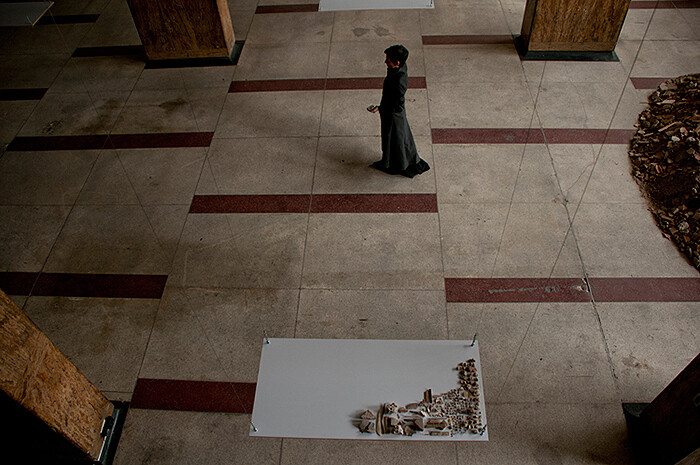Who’s the tiger?
In 2012, the Wall Street Journal headed a report on the emerging economies of Colombia and Peru with the bold headline, “The New Tigers,” pitting them against the Asian “Tigers” of the 1960s–90s. Already projected to become the third largest economy in Latin America by 2014,1 Colombia is a country particularly rich in raw materials—including oil, coal, and gold—and it is one of the largest exporters of coffee worldwide.2 The streets of its capital city of Bogotá are often characterized either by slow-moving traffic or absolute gridlock, reflecting the ubiquitous, post-traumatic effect its repressive political policy imposes on the rituals of daily life.
Launched concurrently with artBO, the International Art Fair Bogotá (which recently celebrated its ninth installment from October 25–28, 2013), the up-and-coming Parisian galerie mor ∙ charpentier initiated María José Arjona’s continuous, four-week performance …pero yo soy el tigre (…but I am the tiger, 2013), which was curated by Eugenio Viola, as the inaugural event of their new branch in Bogotá. Since its founding in 2010, mor ∙ charpentier has primarily focused on artists from Latin America and its diaspora—such as Milena Bonilla, Maria Elvira Escallón, and Oscar Muñoz from Colombia; Teresa Margolles and Yoshua Okón from Mexico; as well as Chile’s Voluspa Jarpa and Argentina’s Liliana Porter—and has carried out initiatives highlighting exchanges between Europe and Latin America. It is certainly no coincidence that the gallery has staked out the Santa Fé city district—known as the center of trafficking and prostitution, it has largely gone uncharted by the local and international art crowd—as the site of the first intervention; one of its owners, Alex Mor, grew up in Bogotá, while Arjona herself, a native of the city, now lives and works between Bogotá and New York City.
Upon entering a building that used to serve as a business center until the 1960s, but now stands as an empty factory hall, a barely audible, soft murmuring breaks the silence; it is the sound of someone counting numbers. On the first day, only the sole voice of Arjona could be heard, on the second day two voices, and every day after that point, an additional voice was added, intensifying the sound. Because the voices are played back with each of the iterations, the previous day’s recordings are literally inscribed into the presence of the following day. But what is exactly being counted here?
As Arjona paces up and down the vast space, her slowed-down, majestic, almost stiff stride—a movement one would not immediately associate with the deft agility of a jungle cat—is enhanced by a high-necked coat that reaches down to the floor. She picks up stones from a large pile of rubble, carries them in small numbers either to a table or a carpet on the floor, and then meticulously organizes them one by one, until she restarts the whole process all over again. Inherent to the artist’s demonstration of physical endurance and mental strength is the idea of “becoming a body,” introducing a tenacity that brings this performance to life. The systematic counting of stones—a mathematical operation and visualization of time—propels the action’s continuous motor, allowing one to calculate the ratio between the amount of material the artist has already transported and what remains left to be done.
In light of this new work, one might be inclined to add the addendum, “and they count, too,” to the phrase: “That bodies speak has been known for a long time.”3 in: The Logic of Sense, Ed. Constantin V. Boundas, Trans. Mark Lester and Charles Stivale (New York: Columbia University Press, 1990), 285. It also was the title of a 2004 exhibition at the Generali Foundation in Vienna, curated by Hemma Schmutz and Tanja Widmann. See http://foundation.generali.at/en/info/archive/2006-2004/exhibitions/that-bodies-speak-had-been-known-for-a-long-time.html (last access November 22, 2013).] This is because the sum of infinite actions in Arjona’s performance involves an abstract network of subjective time-units, producing a kind of numerological body. In an approach similar to a 2008 performance in which she had the words “Remember to Remember” tattooed onto her back as part of her “White” series, the exact number of the stones that Arjona removes after five or six hours of performance are tattooed directly onto her forearm, resulting in the permanent inscription of different numbers on the surface of her body.
Although Arjona’s artistic action incorporates the stones into an archeology of time and materials, this transformation into another frame of reference remains unresolved, casting a unique pathos over the space. The architecture of the hall—an open construction with a single balustrade—causes the audience’s glances and paths to cross continuously with those of the artist, and this interaction becomes the principal act of performance; thus, the piece can only be experienced as a kind of shared “being-in-time,” which Arjona describes as “jointly becoming the tiger.”
While this temporal work involves hard, physical labor, it also proves to be political. Calculating with numbers (in today’s standard of long, digital columns) and defining and examining self-generated, abstract structures are actions that shape today’s economic system and its abstract values. However, both belief in Colombia’s economic growth, as well as the performance’s accumulation and movement of stones, serve to reflect upon this abstract relationship between time and value in very different ways; it leaves us to wonder—does Arjona’s tiger refer to the systemic structures that have dedicated themselves to the economization of time, or does it refer to the individual subjects who, by removing these structures, unfold entirely new “time horizons”?
See Robert Valencia, “The Andean Tigers: Will Colombia and Peru Land on their Feet?,” World Policy Blog, July 31, 2012. http://www.worldpolicy.org/blog/2012/07/31/andean-tigers-will-colombia-and-peru-land-their-feet (last access November 22, 2013).
See Raul Zelik and Dario Azzellini, Kolumbien. Große Geschäfte, staatlicher Terror und Aufstandsbewegung (Cologne and Karlsruhe: Neuer ISP Verlag, 2000).
Gilles Deleuze, “Pierre Klossowski or Bodies-Language” [1979










